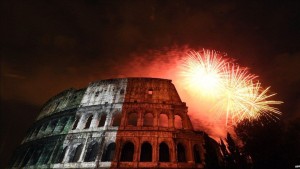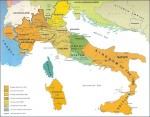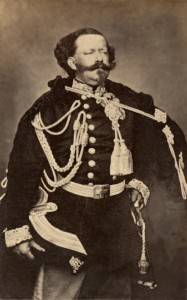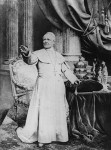 March 17th is not just an important day for the Irish, you know. Today marks the 150th anniversary of Italian unification. On March 17, 1861, the first Italian Parliament proclaimed Victor Emmanuel II, King of Piedmont, Savoy, and Sardinia, the King of the unified state of Italy.
March 17th is not just an important day for the Irish, you know. Today marks the 150th anniversary of Italian unification. On March 17, 1861, the first Italian Parliament proclaimed Victor Emmanuel II, King of Piedmont, Savoy, and Sardinia, the King of the unified state of Italy.
The Risorgimento (resurgence), the movement towards a unified Italy, was a long, messy process that began politically in 1815 at the Congress of Vienna where Italy was carved up by the European powers. This disregard for self-determination only encouraged the growing nationalist sentiment, and revolutionary societies like the Carbonari and La Giovine Italia (the Young Italy) spread like wildfire all over the peninsula. The revolutionary fervor of 1848 which saw dramatic governmental upheavals in almost every country in Europe resulted in constitutional monarchies in many Italian states and even in a brief shining resurrection of the Roman Republic under national heroes Giuseppe Garibaldi (soldier) and Giuseppe Mazzini (politician).
 They were all short-lived, just like the rest of the 1848 revolutions, but they left a taste for freedom and unification in people’s mouths, and the kingdom of Sardinia-Piedmont, most particularly its endlessly-scheming prime minister Count Camillo of Cavour, was keen to kick the Austrians out of northern Italy, kick the Bourbons out of southern Italy, claim the central states from various tin horn dukes and make themselves a brand new country.
They were all short-lived, just like the rest of the 1848 revolutions, but they left a taste for freedom and unification in people’s mouths, and the kingdom of Sardinia-Piedmont, most particularly its endlessly-scheming prime minister Count Camillo of Cavour, was keen to kick the Austrians out of northern Italy, kick the Bourbons out of southern Italy, claim the central states from various tin horn dukes and make themselves a brand new country.
 Thanks to the political machinations of Cavour, Garibaldi’s outstanding military ability and his famous army of red-shirted volunteers, ten years later Victor Emmanuel II found himself King of Italy.
Thanks to the political machinations of Cavour, Garibaldi’s outstanding military ability and his famous army of red-shirted volunteers, ten years later Victor Emmanuel II found himself King of Italy.
(Fun fact about Victor Emmanuel II: he was a Knight of the Garter, an English order of chivalry dedicated to England’s patron saint, St. George of dragon-slaying fame. The Duchess of Sutherland said about Victor Emmanuel II that he was the only Knight of the Garter she had ever seen who “looked as if he would have had the best of it with the dragon.”)
The new Italian Parliament declared Rome the capital, as per its ancient privilege, but they had to do it from Turin because Rome was actually still part of the Papal States (reduced to the region of Lazio) at that point, and the Pope had no intention of coughing up even this sad remnant of his temporal power as long as French troops were there to protect him.
 It wasn’t until August of 1870, a month after the start of the Franco-Prussian War, that Emperor Napoleon III withdrew his final garrison from Rome, leaving the Papal States virtually undefended. Victor Emmanuel didn’t want to storm in, though. He wanted to negotiate a nice, orderly, respectful hand-over. Pope Pius IX, who had been beloved for his liberal reformist ways when first elected to the throne of Peter in the heady revolutionary days of 1846, bitterly refused and instead insisted that he and his wee cadre of papal troops would never let Italian soldiers set foot in the Eternal City.
It wasn’t until August of 1870, a month after the start of the Franco-Prussian War, that Emperor Napoleon III withdrew his final garrison from Rome, leaving the Papal States virtually undefended. Victor Emmanuel didn’t want to storm in, though. He wanted to negotiate a nice, orderly, respectful hand-over. Pope Pius IX, who had been beloved for his liberal reformist ways when first elected to the throne of Peter in the heady revolutionary days of 1846, bitterly refused and instead insisted that he and his wee cadre of papal troops would never let Italian soldiers set foot in the Eternal City.
 Bummed but resigned, the King sent his crack Piedmontese Bersaglieri troops (known for their excellent marksmanship and awesome hats) to claim Rome. They took their time, taking 11 days to go from the border of Lazio to the ancient Aurelian wall that still protected Rome. On September 20th, 1870, they halfheartedly fired cannon at the Porta Pia for three hours then breached the gate and took Rome. The Pope locked himself in the Vatican, refusing to accept the Italian offer to grant him sovereignty over Vatican City on the grounds that any such treaty would be acknowledging the Italian state. There he remained, isolated and bitter, until his death in 1878 while all around him a new country was happening.
Bummed but resigned, the King sent his crack Piedmontese Bersaglieri troops (known for their excellent marksmanship and awesome hats) to claim Rome. They took their time, taking 11 days to go from the border of Lazio to the ancient Aurelian wall that still protected Rome. On September 20th, 1870, they halfheartedly fired cannon at the Porta Pia for three hours then breached the gate and took Rome. The Pope locked himself in the Vatican, refusing to accept the Italian offer to grant him sovereignty over Vatican City on the grounds that any such treaty would be acknowledging the Italian state. There he remained, isolated and bitter, until his death in 1878 while all around him a new country was happening.
Anyway, Italy is celebrating its anniversary in grand style today, with tri-color flags and parades and parties, despite the tense, fractious political environment in the country at the moment. President Obama made a lovely statement, as did Democratic Congressional Leader Nancy Pelosi.
This is such a marvelous story. Thank you for a great encapsulation!
Does “Carbonari” translate to anything?
I also recall Verdi being swept up (not personally exactly, but certainly in the minds of the people) into unification: “Vittorio Emanuele Re d’Italia” turns into “VERDI” quite neatly. Just now, checking the Italian spelling of “Emanuele,” I found that “Viva Verdi” was used as a disguised nationalist cry under the Austrian occupation.
Unfortunately, it’s been a rough time of it for Italy since then.
“Carbone” is charcoal. “Carbonari” would be people who sell it or burn it. Many of their rituals and codes used the lingo of charcoal-sellers. Napoleon III was actually a member, believe it or not, in his youth.
Verdi was very much identified with Italian nationalism, mainly apocryphally as in the story that “Va Pensiero,” the wistful aria sung by the chorus of Hebrew Slaves in Nabucco weeping over their lost country, was a reference to the Austrian occupation of northern Italy.
Sure has. I think it was even rougher before, though.
Celebrating in “grand style”??? Um…well…maybe… But here in Florence (where I live) even San Patrizio (Saint Patrick) got more attention. There was a five-day Irish music festival but only very sporadic “put out more tricolori” moments. And the buzz in the streets fell short of a tied game by our local football team. (You can’t even yell, “Forza Italia!” anymore, since it was co-opted by a political party that everyone despises but still votes for. And “Buon Compleanno, Italia!”—“Happy Birthday, Italy!”—sounds ironic. Implying: “When are you going to grow up, already?” ) The fact that it drizzled most of the day didn’t help.
The right-wing xenophobic Northern League opposed the celebrations outright (their basic tenet is that Italian Unification was a bad idea from the start). The left-ish wing…whoever is still around these days…shrugged it off. Leaving Silvio Berlusconi to bask in the glory. (“Bunga Bunga, Italia!”, anyone?) Several friends in America and Canada asked me to pick up the March 17 newspapers for them and a range of “collectibles”—of which there was just about none (now that is serious!)
In regard to “bad moments”in Italian history: As most Italians will tell you, there were no good moments—if you go by the “leading indicators”! Here in Florence, the Renaissance was actually a period of economic decline (collapse of the wool trade) and underpopulation (two-thirds…maybe…of the inhabitants of the city died in the Black Death of 1347.)
It will be interesting to see if the Florentines get into the spirit for 2015—the 150th anniversary of “Firenze Capitale”. In 1865, the Savoy Court moved from Turin to Florence and remained here until the transfer to Rome in 1870.
BY THE WAY, there was a Goldberg among Garibaldi’s “thousand” who made the fabled landing in Sicily: Antonio Goldberg from Pest. (Honest to God! He is in all the official lists.)